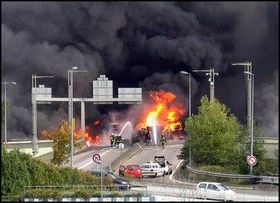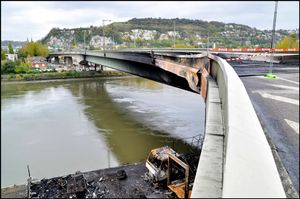|
By accessing or using The Crittenden Automotive Library™/CarsAndRacingStuff.com, you signify your agreement with the Terms of Use on our Legal Information page. Our Privacy Policy is also available there. |

Blue and White Van Man 4 - Diverting Experiences In France
|
|---|
|
|
Blue and White Van Man 4 - Diverting Experiences In France
Stan Potter
DriveWrite
November 21, 2013
Stan Potter writes: Roads in France have changed very rapidly over the years. Every time we go over there seems to be new Autoroutes under construction. Most of them are toll roads operated by private companies and they normally parallel the Routes National which are toll free. The speed limit on the Autoroutes is normally 130kph (80mph) and the main roads 90kph. As the motorways go straight through the middle of some towns it is possible to cruise at high speed for hours on end. The main roads cut through every village and town (50kph) so progress is much slower.
The French have an idea that we could use on our cramped roads. They have three lane roads with two lanes in one direction and one in the other. The allocation of the two lanes is fair and well signposted. So even if you are stuck behind a slow tractor, lorry or caravan, you will get your chance to overtake. Interestingly the speed limit for cars towing trailers, horse boxes or caravans is the same as a solo vehicle.
Our van cruises happily at 65-70 mph and we are often overtaken by large cars or 4x4s towing at 80+mph; this can be quite unnerving. Unless there are speed cameras or Police in the area, speed limits are treated by the locals as at best advisory. In fact, the French seem to treat most regulations, especially those emanating from Brussels, as to be considered and then probably ignored.
French roads are generally well maintained except in large towns where I think bumps and potholes are used as a means of traffic calming. There is a habit that when repairs are required the road is closed and a few diversion signs are put out. Enough to lure you into a false sense of security but usually not enough to get you back onto your route. Make sure you have a map or sat-nav! It is a good idea when driving through France not to run your fuel level too low as there can often twenty miles between petrol stations and if the one you were counting on is closed, as has happened to us, it can easily become a major problem because fuel is not as easily available as in UK.
A good example of French diversions is to be found in Rouen. This is on the main route from the Channel ports to Brittany, the Vendée and Bordeaux. On 12th October 2012 a road tanker caught fire on the Pont Mathilde, badly damaging the bridge. This is the optimum crossing of the River Seine on this route but it will be closed for the foreseeable future. There is virtually no diversion signage so you are left to your own devices. The recommended diversion starts 30 miles north of Rouen and involves the A29 toll motorway! Most routes through France advise you to go via Paris. I personally do not recommend this as it involves the Boulevarde Peripherique which is the Paris ring road. Imagine if you can the busiest section of the M25 at rush hour with everyone driving at 60+ mph and not giving way to anybody. That almost sums it up. But if you do decide to chance it a sat-nav is a must as it will ensure you are in the correct one of six lanes. French drivers tend to treat any car with foreign plates as a challenge that must be overtaken as soon as possible, but generally the standard of driving is good, probably better than the UK. The alcohol level permitted for driving in France is lower than UK but it is not uncommon, at any time of day or night, to observe vehicles being driven unusually slowly, wandering along. This is most common in rural areas where, due to generally low crime rates, policing is sparse. But I generally feel safer driving in rural France than most other countries.




















